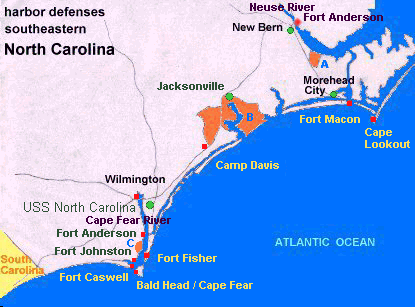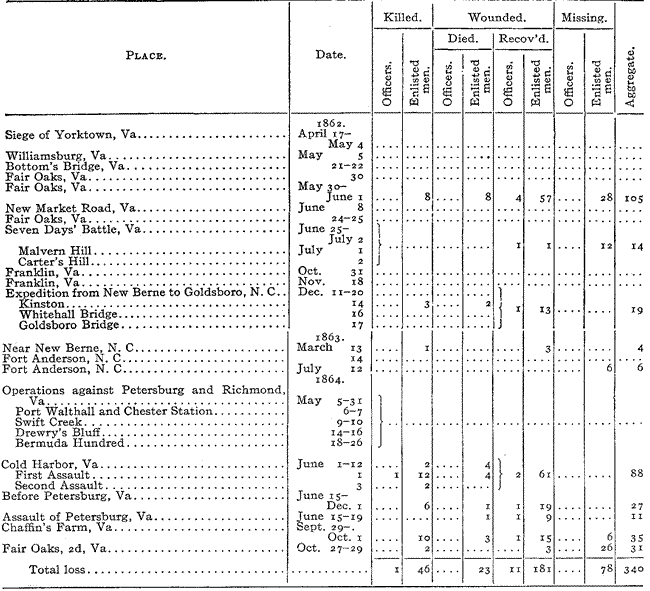|
Union and Confederate Army and Naval operations in the vicinity of the Neuse River
The following excerpts are from U.S. Army soldiers' letters and Federal Army correspondence that
appeared in the Potsdam [New York] Courier Freeman on March 9, 1864. The excerpts are regarding Union and Confederate
Army and Naval operations in the vicinity of the Neuse River, near New Bern, North Carolina.
| NC Coast Map and the Civil War |

|
| North Carolina Coast and the Civil War |
The Fort Anderson mentioned in this newspaper,
garrisoned by the 92nd New York Infantry Regiment, Lieutenant Colonel Hiram Anderson, Jr.*, commanding, was an earthwork on
the north bank of the Neuse River directly opposite New Bern.
Named in honor of its commander, Fort Anderson, located in Craven County, was flanked on both sides by swamps and was
approachable only in front along a narrow causeway. Fort Anderson is often and easily mistaken for Fort Anderson to its south in Brunswick County, located adjacent the Cape Fear River and just north of Fort Fisher. To
differentiate between the two, modern-day historians generally refer to the forts as either Union or Confederate. Lt.
Col Anderson, Jr., the fort's namesake, would become the regiment's only officer killed in action. See also North Carolina American Civil War Battles and Battlefields.
| Operations at Fort Anderson, Neuse River |

|
| Potsdam [New York] Courier Freeman March 9, 1864 |
(About) Potsdam [New York] Courier Freeman, March 9, 1864. Although the Battle of Fort Anderson was
contested March 13-15, 1863, the Courier Freeman mentions the fort the following year in a brief chronology of events.
Lt. Col. Hirman Anderson, Jr. would be killed three months later on the first day of fighting at Cold Harbor, VA.
| Assignments & Casualties: 92nd New York Infantry |

|
| Official Records of the Union and Confederate Armies |
(About) Total casualties for the Ninety-second New York Infantry Regiment.
During its organization, the 92nd New York lost 1 officer in killed and 2 officers died of disease. 67 enlisted
men were killed or mortally wounded, while an additional 115 died of disease. Total deaths 185. Official Records of the Union and Confederate Armies.
Recommended Reading: The Civil War in the Carolinas
(Hardcover). Description: Dan Morrill relates the experience
of two quite different states bound together in the defense of the Confederacy, using letters, diaries, memoirs, and reports.
He shows how the innovative operations of the Union army and navy along the coast and
in the bays and rivers of the Carolinas affected the general course of the war as well as
the daily lives of all Carolinians. He demonstrates the "total war" for North
Carolina's vital coastal railroads and ports. In the latter part of the war, he describes
how Sherman's operation cut out the heart of the last stronghold
of the South. Continued below...
The author
offers fascinating sketches of major and minor personalities, including the new president and state governors, Generals Lee,
Beauregard, Pickett, Sherman, D.H. Hill, and Joseph E. Johnston. Rebels and abolitionists, pacifists and unionists, slaves
and freed men and women, all influential, all placed in their context with clear-eyed precision. If he were wielding a needle
instead of a pen, his tapestry would offer us a complete picture of a people at war. Midwest Book Review: The Civil War in the Carolinas by civil war expert and historian
Dan Morrill (History Department, University of North Carolina at Charlotte, and Director of the Charlotte-Mecklenburg Historical
Society) is a dramatically presented and extensively researched survey and analysis of the impact the American Civil War had
upon the states of North Carolina and South Carolina, and the people who called these states their home. A meticulous, scholarly,
and thoroughly engaging examination of the details of history and the sweeping change that the war wrought for everyone, The
Civil War In The Carolinas is a welcome and informative addition to American Civil War Studies reference collections.
Recommended Reading: The Civil War in North Carolina. Description: Numerous
battles and skirmishes were fought in North Carolina during
the Civil War, and the campaigns and battles themselves were crucial in the grand strategy of the conflict and involved some
of the most famous generals of the war. John Barrett presents the complete story of military engagements across the state,
including the classical pitched battle of Bentonville--involving Generals Joe Johnston and William Sherman--the siege of Fort Fisher, the amphibious
campaigns on the coast, and cavalry sweeps such as General George Stoneman's Raid.
Recommended Reading: Ironclads and Columbiads: The Coast
(The Civil War in North Carolina) (456 pages). Description: Ironclads and Columbiads covers some of the most
important battles and campaigns in the state. In January 1862, Union forces began in earnest to occupy crucial points on the
North Carolina coast. Within six months, Union army and
naval forces effectively controlled coastal North Carolina from the Virginia
line south to present-day Morehead City.
Union setbacks in Virginia, however, led to the withdrawal of many federal soldiers from North Carolina, leaving only enough
Union troops to hold a few coastal strongholds—the vital ports and railroad junctions. The South during the Civil War,
moreover, hotly contested the North’s ability to maintain its grip on these key coastal strongholds.
Recommended Reading: The
Civil War in Coastal North Carolina (175 pages) (North Carolina Division of Archives and History). Description: From the drama of blockade-running to graphic descriptions of battles
on the state's islands and sounds, this book portrays the explosive events that took place in North Carolina's
coastal region during the Civil War. Topics discussed include the strategic importance of coastal North Carolina, Federal occupation of coastal areas, blockade-running, and the impact of
war on civilians along the Tar Heel coast.
Recommended Reading: Storm
over Carolina: The Confederate Navy's Struggle for Eastern North Carolina. Description: The struggle for control of the eastern
waters of North Carolina during the War Between the States
was a bitter, painful, and sometimes humiliating one for the Confederate navy. No better example exists of the classic adage,
"Too little, too late." Burdened by the lack of adequate warships, construction facilities, and even ammunition, the
South's naval arm fought bravely and even recklessly to stem the tide of the Federal invasion of North
Carolina from the raging Atlantic. Storm
Over Carolina is the account of the Southern navy's struggle in North
Carolina waters and it is a saga of crushing defeats interspersed with moments of brilliant and even
spectacular victories. It is also the story of dogged Southern determination and incredible perseverance in the face
of overwhelming odds. Continued below...
For most of
the Civil War, the navigable portions of the Roanoke, Tar, Neuse, Chowan, and Pasquotank rivers were
occupied by Federal forces. The Albemarle and Pamlico sounds, as well as most of the coastal towns and counties, were also
under Union control. With the building of the river ironclads, the Confederate navy at last could strike a telling blow against
the invaders, but they were slowly overtaken by events elsewhere. With the war grinding to a close, the last Confederate vessel
in North Carolina waters was destroyed. William T. Sherman
was approaching from the south, Wilmington was lost, and the
Confederacy reeled as if from a mortal blow. For the Confederate navy, and even more so for the besieged citizens of eastern
North Carolina, these were stormy days indeed. Storm Over Carolina describes their story, their struggle, their history.
|

